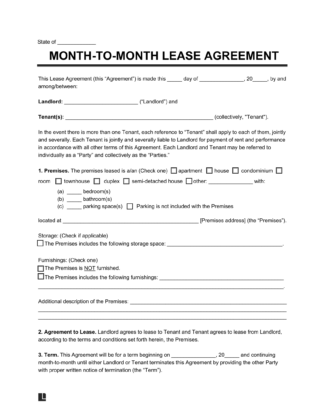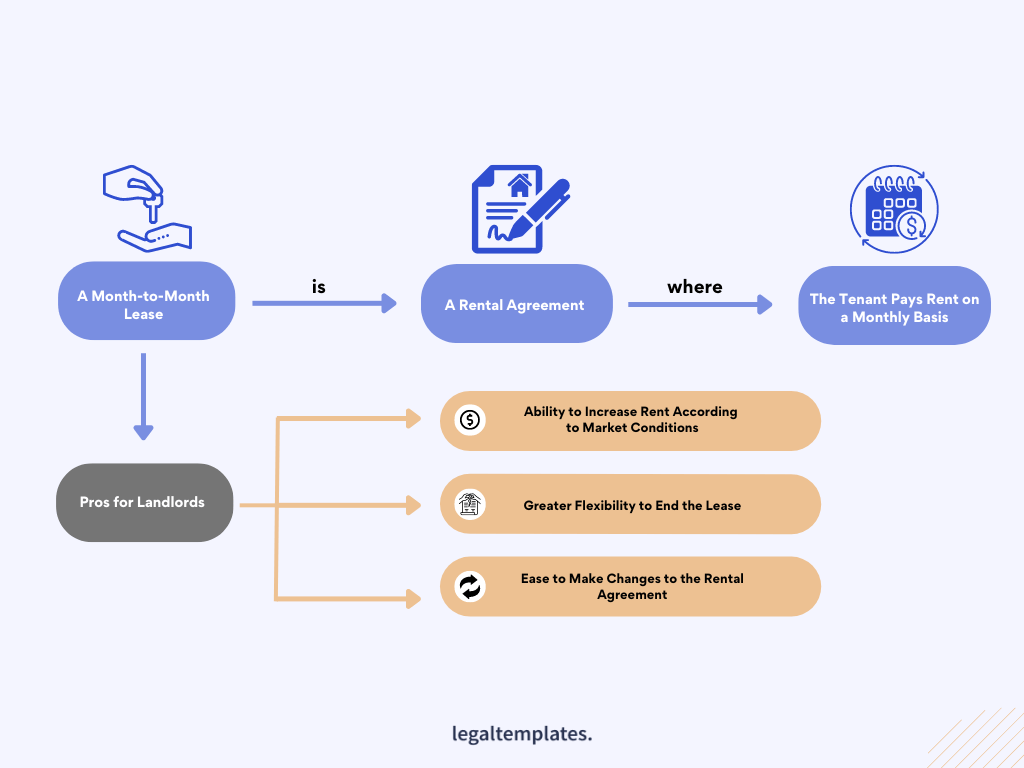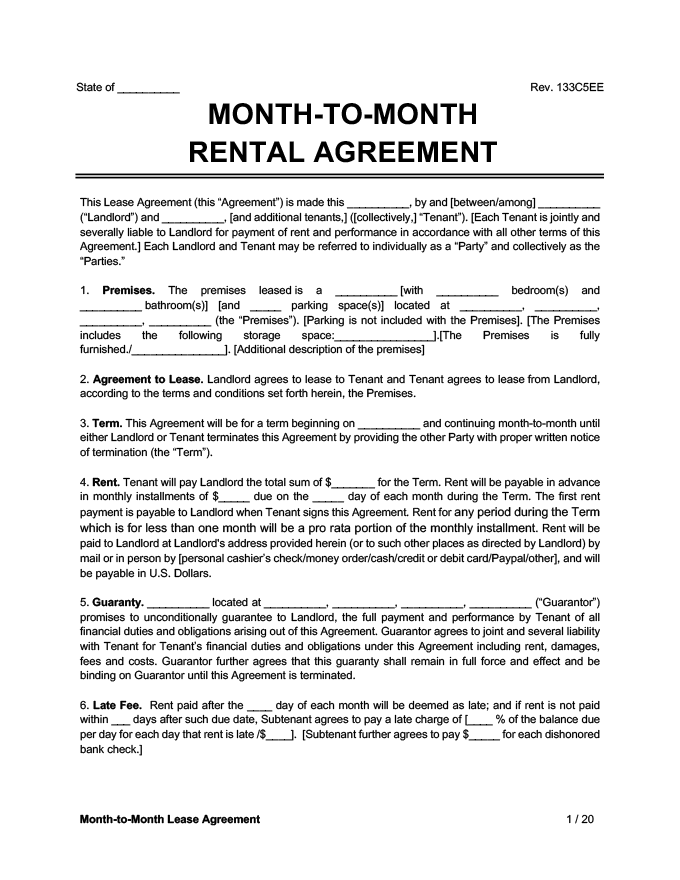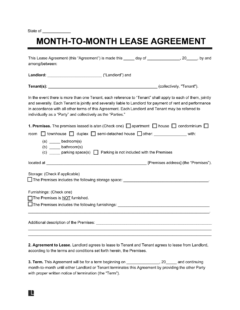
Use our month-to-month rental agreement to rent out your property on a monthly basis.

Updated May 30, 2024
Written by Sara Hostelley | Reviewed by Susan Chai, Esq.
A month-to-month rental (lease) agreement outlines a formal relationship between a property owner and a tenant to rent residential property on a month-to-month basis. It creates a tenancy at will with an undetermined end date.
A month-to-month rental contract usually requires either party to provide 30 days’ notice before terminating. This requirement distinguishes it from a fixed-term lease, which expires at the end of a defined period (such as six months, nine months, one year, etc.). Both parties usually can’t terminate a fixed-term lease early without consequences.
Here are the key elements to include in a month-to-month lease agreement:

Request information from the tenant via a rental application to ensure they’re a good candidate for renting your property. Use an employment verification letter to learn an individual’s current or past employment status before committing to a month-to-month lease with them.
You can also ask them to complete a background check authorization form, allowing you to conduct a background check on them without legal repercussions. You may collect a fee from the tenant to conduct this check. Some websites to use for conducting background checks include the following:
Once you confirm the tenant is a suitable candidate, you can start negotiating the terms of the month-to-month lease, such as the following:
Use the verbal negotiations with the tenant to write a formal month-to-month lease. Please abide by all legal requirements, including local housing laws and habitability standards.
Depending on where you live, you may have to include specific disclosures. For example, 42 US Code § 4852d requires landlords in all states to provide a lead-based paint disclosure statement if the housing was built before 1978. Furthermore, the following states require landlords to provide a rental inspection checklist to the tenant upon move-in:
| State | Law |
|---|---|
| Arizona | Ariz. Rev. Stat. § 33-1321 |
| Georgia | Ga. Code § 44-7-33 |
| Hawaii | Haw. Rev. Stat. § 521-42 |
| Kansas | Kan. Stat. § 58-2548 |
| Kentucky | Ky. Rev. Stat. § 383.580 |
| Maryland | Md. Code, Real. Prop. § 8-203.1 |
| Massachusetts | Mass. Gen. Laws ch. 186 § 15B |
| Michigan | Mich. Comp. Laws § 554.608 |
| Montana | Mont. Code § 70-25-206 |
| Nevada | Nev. Rev. Stat. § 118A.200 |
| North Dakota | ND Cent. Code § 47-16-07.2 |
| Virginia | Va. Code § 55.1-1214 |
| Washington | Wash. Rev. Code § 59.18.260 |
| Wisconsin | Wis. Admin. Code ATCP § ATCP 134.06 |
| Show More Show Less | |
If you write the lease but forget to address certain topics or provisions, you can use the following addendums to make the document more comprehensive:
Have both parties sign the lease once they’re content with its terms. Allow the tenancy to begin on the date the agreement indicates and enforce all terms. Let the lease renew monthly for an undefined period until either party wishes to terminate.
A month-to-month lease continues indefinitely, so you must navigate changes properly to remain in compliance with state and city laws and maintain a good relationship with your tenant.
For example, suppose you have a tenant who’s been on a month-to-month lease with you for longer than anticipated. If you need to raise their rent to keep up with market conditions, you can’t do so randomly without informing them. You must provide proper notice to comply with regulations. Use a notice of rent increase and abide by the notice period requirements in your area.
You may also need to implement amendments to account for changing circumstances. For example, you may write a rent forgiveness amendment to help a tenant struggling to meet their rent payments or an add/remove tenant amendment to account for a tenant’s arrival or departure.
Unlike a standard fixed-term lease (e.g., a one-year lease), a month-to-month rental agreement automatically renews at the end of each rent payment period unless either party decides to terminate the tenancy.
Make sure to check the specific legal requirements in your area to ensure compliance with the appropriate notice period.
After terminating a month-to-month lease, you can prepare the unit for a new tenant. Complete a move-out inspection, checking for signs of damage versus normal wear and tear to determine if you must return the old tenant’s security deposit. Perform a deep cleaning and address any maintenance issues.
Advertise the unit and find a new tenant willing to rent on a month-to-month basis. From here, you can start the process over again.
When your old tenant moves out, you may write them a letter of recommendation if they proved they were a responsible, polite, and clean tenant. This letter may help them find a new housing situation, which can help you maintain a good relationship with them in case they seek housing with you again in the future.
A fixed lease may convert into a month-to-month lease under certain circumstances:
Explore the pros and cons of month-to-month lease agreements for landlords:
1. Landlord. Provide the landlord’s full name or company name, depending on whether the landlord is an individual or an entity.
2. Tenant. Write the tenant’s full name or company name, depending on whether the tenant is an individual or an entity. If there is more than one tenant, enter the name of each additional tenant.

3. Premises. Describe the rental. Specify the type of residential property being rented, such as an apartment or a house. You can write one in if none of the options provided describe the property type.
Please provide the number of bedrooms, bathrooms, and parking spaces (if parking is included with the property). Also, please provide the property’s street (physical) address, including the apartment/unit number (if applicable), city, state, and zip code.

4. Storage. Specify whether the rental property includes any storage space. If yes, describe the storage space.

5. Furnishings. State whether the rental property will include any furnishings. If yes, provide a list of the furnishings included with the rental.

6. Additional Description. If any additional information would help describe the property, include it here.

7. Term. Provide the start date of the lease.

8. Rent. Specify the dollar amount of the monthly rent payment, the day it is due (e.g., the 5th day of the month), and the payment method.

9. Proration. State whether the rent for less than one month will be prorated.

10. Bounced Check. Write the amount the landlord will charge for any bounced checks.

11. Guaranty. Specify whether a guarantor is required for the tenant under this lease. If yes, provide the guarantor’s full name and address.

12. Late Fee. State whether a late fee will be charged if the rent is not paid on time. If yes, specify the day of the month the rent will be considered delinquent and the number of days for any grace period.
If a late fee is assessed, select whether it will be a set dollar amount (including the amount) or a percentage amount.

13. Utilities. Note if the landlord will be responsible for any utilities and indicate which. (Typically, the tenant is responsible for all utilities.)

14. Security Deposit. Provide the dollar amount of the security deposit to be paid by the tenant to the landlord.
Enter the number of days after the end of this agreement that the landlord will return the security deposit (less any amounts under this section) to the tenant.
Specify whether the security deposit will be held in an interest-bearing account.
*Note that most states have laws regarding security deposits, the amount, where they’re saved, how they can be used, and when they must be returned to the tenant.
 lease security deposit" width="1024" height="276" />
lease security deposit" width="1024" height="276" />
15. Use. The tenant and the tenant’s immediate family will use the property for residential purposes. In addition, the tenant is responsible for any damage caused to the property by their guests. Write any additional guest or visitor policy.

16. Condition. The tenant agrees to the current condition of the appliances, fixtures, and furnishings (if applicable) other than any exceptions to be added here.

17. Maintenance and Repairs. The tenant agrees to maintain the property and not remove any appliances, fixtures, and furnishings (if applicable). If the property has an outside area or grounds, the tenant also agrees to maintain those.

18. Rules and Regulations. Specify whether there are separate rules and regulations for the rental property. If there are, a sample “Exhibit A – Rules and Regulations” is included at the end of this agreement for your reference.

19. Military Clause. State whether the tenant may terminate the lease agreement early for activity duty in the US Armed Forces.

20. Smoking. Note whether smoking is permitted on the property.

21. Pets. Explain whether tenants are allowed to keep pets on the property. If yes, specify the type of pet(s) and the amount of any pet deposit.

22. Inspection Checklist. Specify whether the tenant must complete an Inspection Checklist at the time of move-in.
If yes, a sample “Exhibit B – Rental Inspection Checklist” is included at the end of this agreement.

23. Renter’s Insurance. State whether the tenant is required to obtain a renter’s insurance policy.
If yes, the policy must have at least $100,000 of personal liability coverage, and the landlord must be named as an interested party or additional insured.

24. Assignment and Subletting. Write whether the tenant can assign or sublease any part of the property.
If allowed, specify whether the tenant must obtain the landlord’s written consent to assign or sublease.
25. Default. In the event of default (other than failure to pay rent), the landlord may give the tenant notice and the opportunity to correct the default.
Provide the number of days the tenant has to correct the default. If the default is the tenant’s failure to pay rent, specify the number of days after receipt of the landlord’s notice that the landlord can terminate this agreement.
*Note that most states have laws regarding the amount of notice a landlord must give a tenant for failure to pay rent or other violations of lease terms.
26. Lead Disclosure. If the property was built before 1978, the landlord must disclose whether it contains known lead-based paint or lead-based paint hazards.
A “Disclosure of Information on Lead-Based Paint or Lead-Based Paint Hazards” is included at the end of this agreement for your reference.

27. Notices. All notices must be in writing. Enter the address where the notices should be sent to the landlord and tenant.

28. State Law. Fill in the state’s laws that will govern the construction of this agreement.

29. Disputes. If there is a dispute, specify whether the dispute will be resolved through court litigation, binding arbitration, mediation, or mediation then arbitration.

30. Miscellaneous. Provide for any other provisions not already included in this agreement.

Below, you can see what a month-to-month rental lease agreement typically looks like:


Create Your Month-to-Month Rental Agreement in Minutes!